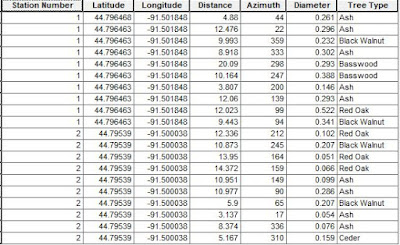The second exercise of the course dealt with the surveying of a grid based coordinate system on small plots. In order to have a quality survey, a geographer needs to have precise GPS technology. However, in some cases this technology can not always be relied on, and therefore one needs to improvise. By using various hand-held tools to measure distances and azimuths one ran coordinate different points to create a map. In this case the latitude and longitude will only be given for the base points of which one stands. The surrounding trees will all be mapped according to the distance from that origin point.
Study Area:
This Field Activity was done on Putnam trail, which is located south of Phillips hall (see figure 1). The base points were roughly 300-400 feet from the back of Phillips. Data was collected from standing on the dirt path, and picking ten of the surrounding trees for the measurements. The trees utilized for data collection were chosen by the groups rotating 360 degrees without moving from the base point. The red path below is rough estimate of the Putnam trail location.
 |
| Figure 1 displays the study area of the Distance Azimuth Survey. |
Methods:
In order to get the survey results, each group had to record the latitude and longitude of the base point, the azimuth of the tree from the origin spot, the circumference of the tree, and the distance from the base point. The gadgets this class used to help obtain these statistics were: a GPS, a hand-held laser measure, a measuring tap, and a azimuth compass. This group also recorded the tree types thanks to the professor's guidance.
 |
| Figure 2 displays the hand-held azimuth compass |
 |
| Figure 3 shows the GPS used to mark the two origin locations |
The GPS unit, shown in Figure 3 was used to record the location for both origin points in the survey. Due to the low-technology of the given GPS make sure to write down the coordinates in a hard copy.
 |
| Figure 4 displays the Measuring Tape |
The measuring tape in Figure 4 was used to measure the circumference of the tree in meters. This is one the of the quickest and simplest ways to record the circumference.
 |
| Figure 5 Displays the hand-held laser measuring device |
The last gadget used during the survey was the hand-held laser measuring device, shown in Figure 5. Aiming the laser pointer directly at a tree will show the exact distance from the the origin spot to that tree in meters.
Each group used the previously explained techniques to collect the data on ten different trees at two different base points. Once all data for the Distance azimuth survey is recorded, it needs to be entered into a Microsoft office excel sheet, and then imported to Arc Map (shown in Table 1).
 |
| Table 1 displays the full results of the data recorded from the two base points |
Importing the Data into ArcMap:
 |
| Figure 6 displays the data inputted into the correct field |
After that utilize the Feature Vertices to Points command also in the arc toolbox. This tool can be found ten or so tools down from the Bearing Distance to Line command tool, but you can also just search for it. This tool will allow you to create a new feature class made up of points that are generated from specific locations. Enter the new tree feature class under input features, choose a name under output feature class, and lastly select end for the point type. The points will be placed on the end of the polylines created by the Bearing Distance to Line command. Then right click on the newly created feature class, go to properties, and under 'symbol' make a proportional symbol map based off the tree diameter. Any maps created must include a north arrow, a scale bar, a locator map, a watermark, and a data source.
Results:
Once you have completed all the steps under the methods subheading, the results will be ready. This group had very few complications while completing the methodology portion, but going through the previously explained methods above, the solution to any issues should be obtainable. As you can see in Figure 7, this distance azimuth survey proved that by using a compass, a laser pointer, a measuring tape, and a azimuth recorder, a fairly accurate map can be produced. Any inaccurate data can be blamed on human error, but for the most part all the trees seem to be the exact distance away from the base point as they were in the field.
 |
| Figure 7 displays the final map created emphasizing on Tree Diameter. |
 |
| Figure 8 shows a county level view of the study area |
Conclusion:
After completing the Distance Azimuth survey, the grid based coordinate system proved to be an accurate way to map the necessary technology isn't working. It is a simple technique, making it easy to acquire the data necessary without the technology. With that being said there is more room for human error when it comes to collecting the points. The assignment went pretty smoothly, but the only error I came across were slightly inaccurate GPS points
Sources:
Hupy, Joseph. (2017). Field Activity #4: Conducting a Distance Azimuth Survey. [PDF Document]. Retreived from : UWEC D2L, Geography 336.001 Lab Contents.
Teh, Steve. Biology 3A: Ecology: Point-Quarter Sampling. Report no. 3A. Biologiical Services Department, Saddleback University.
No comments:
Post a Comment